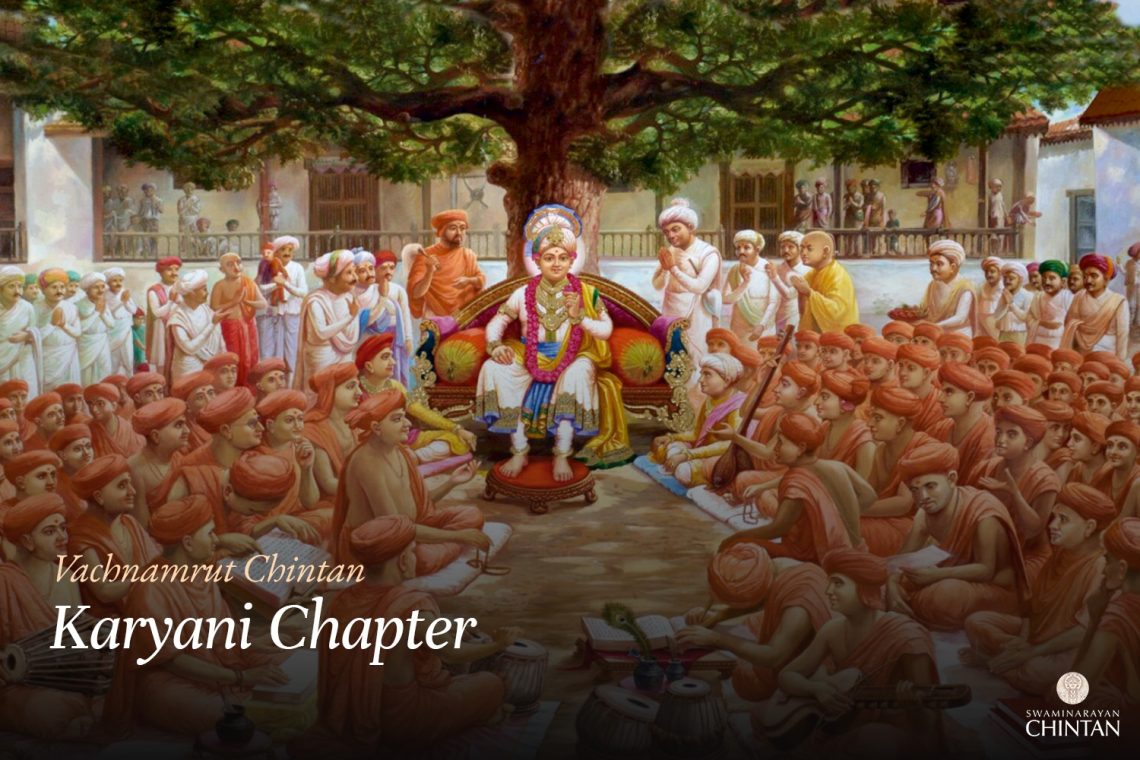Central Insights:
- The factors that contribute to the constant and increasing devotion in Satsang.
Main Points:
- Especially during youth, one who is aware that certain behavior is inappropriate and continues to recognize that it is not right, progresses in Satsang.
- Disinterest in the company of children, lack of taste for the flavors of the tongue, and bodily Daman are signs of progress.
- Constant growth in devotion is achieved through affectionate association with a Satpurush.
- Abandoning ignorance or foolishness is essential.
Commentary:
This Vachanamrut emphasizes constant spiritual growth. Maharaj says that Shukmuni is a great Sant. Since the day he has been in close association with me, his devotion has only increased, and it has never diminished. Hence, he is like Muktanand Swami. After stating this, Maharaj continues to explain how one can maintain ever-increasing devotion in Satsang. On the other hand, it is indirectly stated how one may fall back in Satsang. Sadguru Gunatitanand Swami has also mentioned that virtues, humility, and service are the means of progress, while stubbornness, pride, and jealousy are the means of decline.
Maharaj mentions here in the Vachanamrut that due to the natural virtues within a person’s nature, a Bhakta continuously progresses in Satsang. Conversely, a person who succumbs to the faults ingrained in their nature will eventually descend completely out of Satsang. These virtues and vices cannot be recognized from outward behavior. The true measure of a person’s virtues and faults is revealed by living closely with them. Only through close association can these virtues and faults be observed. They become apparent during various activities such as speaking, walking, eating, drinking, sleeping, rising, sitting, and other such actions.
A person’s natural disposition is such that they hide their weaknesses deep within their heart, ensuring that others do not see them. They may even mask their shortcomings with pretense or drama to make a good impression. If someone tries to probe for these weaknesses, the individual uses all their strength to suppress and conceal them. However, even these weaknesses crave nourishment and eventually surface. They may emerge when the person is in extreme solitude or when there is an opportunity to indulge without fear of judgment. At times, when a person attains power, these hidden faults rise to the surface. Therefore, one’s virtues and faults are not immediately apparent, and recognizing them, especially faults, can be quite challenging.
The path of renunciation (Tyagashram) often blinds the aspirant by instructing, “Do not perceive any faults in us. If you must, then find faults in others, and we will help you!” This is the reality of such situations. Thus, Maharaj states that the true nature of a person cannot be judged from outward actions but only after living closely with them. In Vachanamrut Loya Pratham, Maharaj has mentioned that even if one stays distant, keeping close observation will still reveal their virtues and faults. Specifically, weaknesses such as lust are more prominent in youth. In childhood, these weaknesses may not be visible, but they manifest in youth, while some who appear unruly in childhood may become virtuous in youth. Therefore, true understanding is only gained during youth. Even if there is a natural increase in faults during youth, one who persistently identifies and rejects inappropriate behaviors in their mind will continue to progress in Satsang. Such a person knows that this behavior is unacceptable and constantly strives to avoid it. Those who lack vigilance and are negligent fall behind.
Maharaj then shares His own experience to illustrate the signs of progress, recounting His thoughts and disposition from childhood. Maharaj says that those who are destined to be virtuous in the future will not enjoy the company of children or relish in food. They will engage in bodily Daman. He then shares His childhood resolve to rid His body of the blood and flesh inherited from His mother, ensuring that His body would become so emaciated that only water, not blood, would flow if He were injured.
In Satsangijivan, similar principles are expressed, stating that those who possess these qualities can progress on the path of Satsang:
बाले योषिति दर्पणे निजजने रागे धने मादके
जायन्ते सुधियोऽपि विह्वलतरा होलादिनोत्क्रीडने ।
अष्टस्वेषु तदङ्घिचिन्तनरतं चित्तं न यस्योत्सरेत्
तद्भक्त्येकरसस्य तस्य पदयोः पांशु सुरैरिष्यते ।।
bāle yoṣiti darpaṇe nijajane rāge dhane mādake
jāyante sudhiyo’pi vihvalatarā holādinotkrīḍane |
aṣṭasveṣu tadaṅghricintanarataṁ cittaṁ na yasyotsaret
tadbhaktyekarasasya tasya padayoḥ pāṁśu surair iṣyate ||
Even the wise lose themselves in the indulgences of youth, but the one whose mind does not waver amidst these eight enjoyments is worshipped by the gods.
(Satsangijivan 2.51.50)
Even the intelligent can be overwhelmed by these eight pleasures, but those who are not drawn to them, or can restrain their mind from them, can progress on the path to Bhagwan.
Bhajananand Swami then asked, “Maharaj, is it right for one to merely hold such thoughts, or should one weaken the body through Daman?” Maharaj responded, saying, “Both are necessary. Bodily Daman eliminates physical defects, while mental deliberation (Vichar) removes mental defects. If one practices only bodily Daman, it addresses physical defects, but if mental Vichar is not practiced, the mind’s defects may resurface and reintroduce those bodily flaws, rendering the effort futile. On the other hand, if one practices only mental Vichar without Daman, the body’s defects may hinder mental progress. Therefore, both are required.”
Maharaj distinguishes between bodily and mental defects, showing that indulging in physical desires while justifying them in the mind indicates a decline in Satsang. Identifying and making an effort to eradicate these faults is a sign of rising devotion in Satsang. If one finds satisfaction in such indulgences, or if these vices become enjoyable, it signals a fall from Satsang. Although one may not be physically distanced from Satsang, their heart may have already drifted far from it. Thus, Maharaj explains that both bodily Daman and mental Vichar are necessary, even for a Grihastha Satsangi (householder devotee), and are essential for a Tyagi (renunciate).
Shri Nishkulanand Swami then asked, “Maharaj, can one live in this manner by mental Vichar or through Vairagya?” Maharaj replied, “This is only possible through the association of a great Sant. Such a state is achieved by living in an environment that encourages Vichar and Daman. Such an atmosphere is naturally created where great Santo reside, and even an ordinary person will find it easy to live this way in such an environment. If great Santo do not possess these qualities, no amount of instruction or authority can create such an environment. Without this atmosphere, even those with Vairagya will struggle to live accordingly. Vairagya does assist, but it is the conducive environment that offers more support. If one cannot live in this manner even after being in the presence of great Santo, they are truly sinful because their sins and impurities are so great that even a good environment and the Satsang of great souls cannot purify them.”
Maharaj concludes by explaining that those who remain in Satsang but still indulge in faults have not truly understood its essence. They are like dogs that, in desperation, try to eat stones, but upon failing to chew them, vomit even the food they had previously consumed. In this way, Maharaj illustrates that those who indulge in such foolishness fail to recognize the gravity of their actions. If they truly understood, they would not retain inappropriate behaviors.
Glossary
| Satsang – Holy fellowship |
| Satpurush – A true saint or spiritual guide |
| Satpurush – A true saint or spiritual guide |
| Swabhav – Nature |
| Tyagashram – Life of renunciation A stage of life dedicated to renouncing worldly attachments to focus on spiritual pursuits. |
| Bodily Daman – Physical restraint |
| Vairagya – Detachment From Everything Except God |
| Pride – Arrogance |
| Jealousy – Envy towards others’ progress |
| Indulgence – Over-involvement in sense pleasures |
| Tyagi – Renunciate, A spiritual aspirant who abandons material attachments for Bhagwan. |
| Grihastha Satsangi – Householder Devotee |

